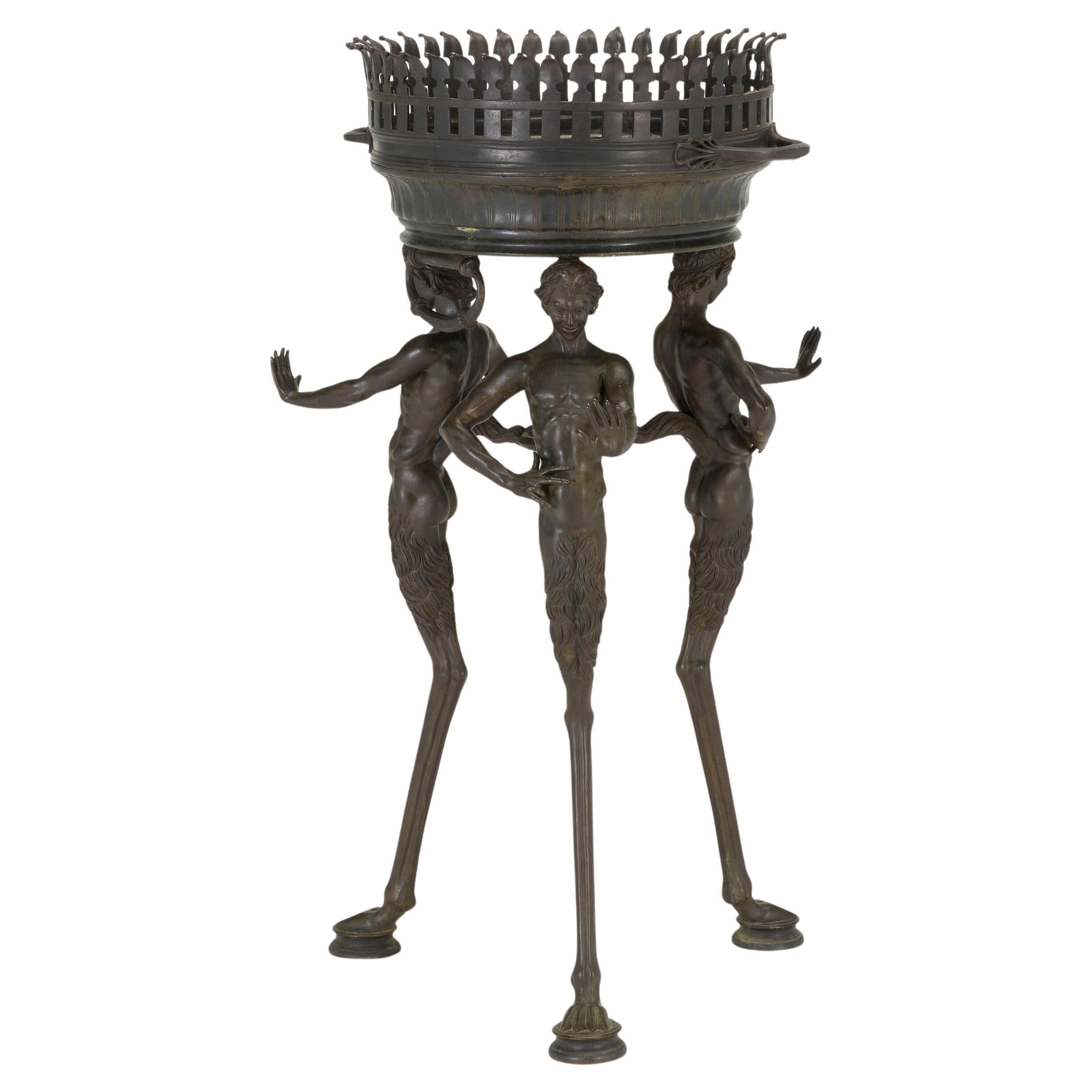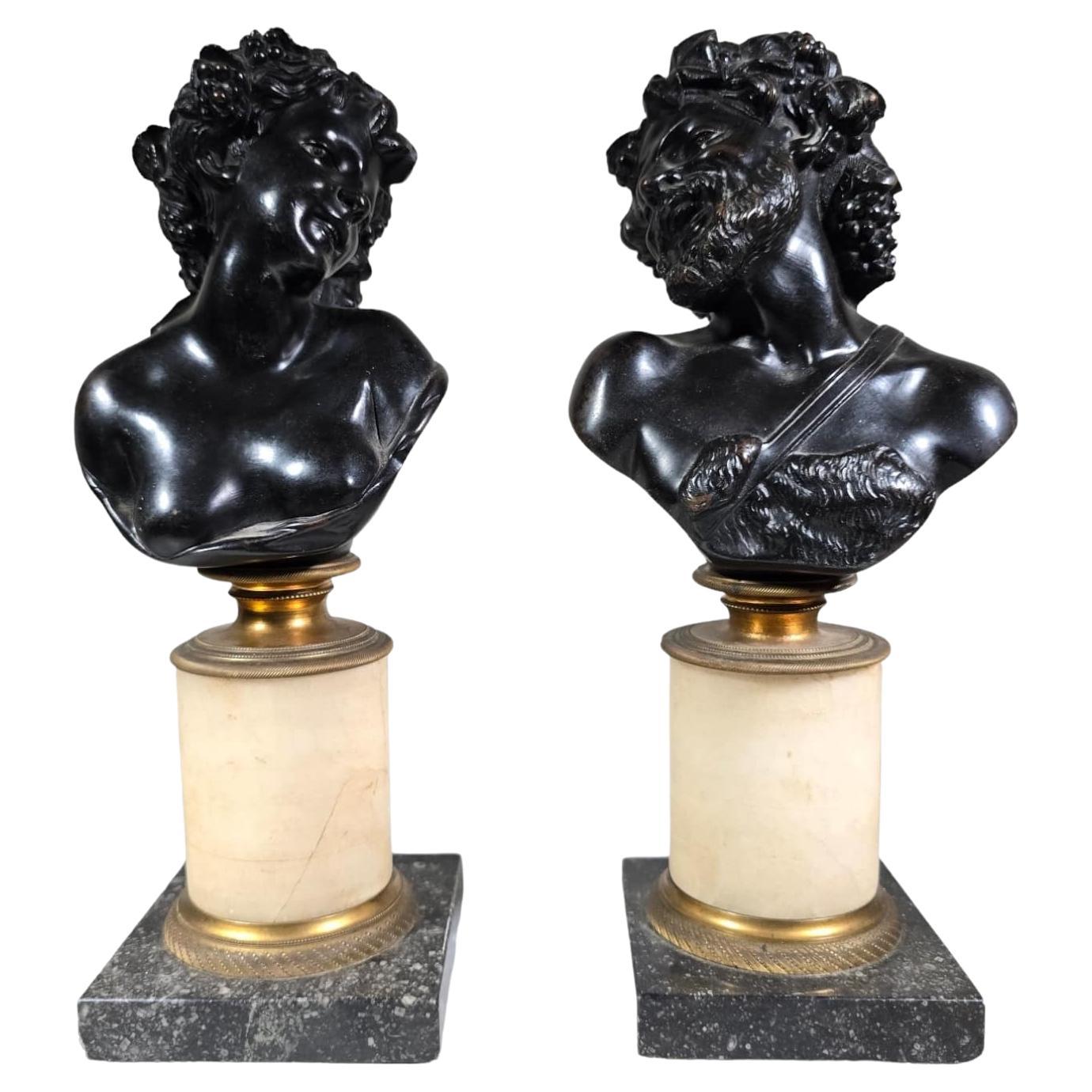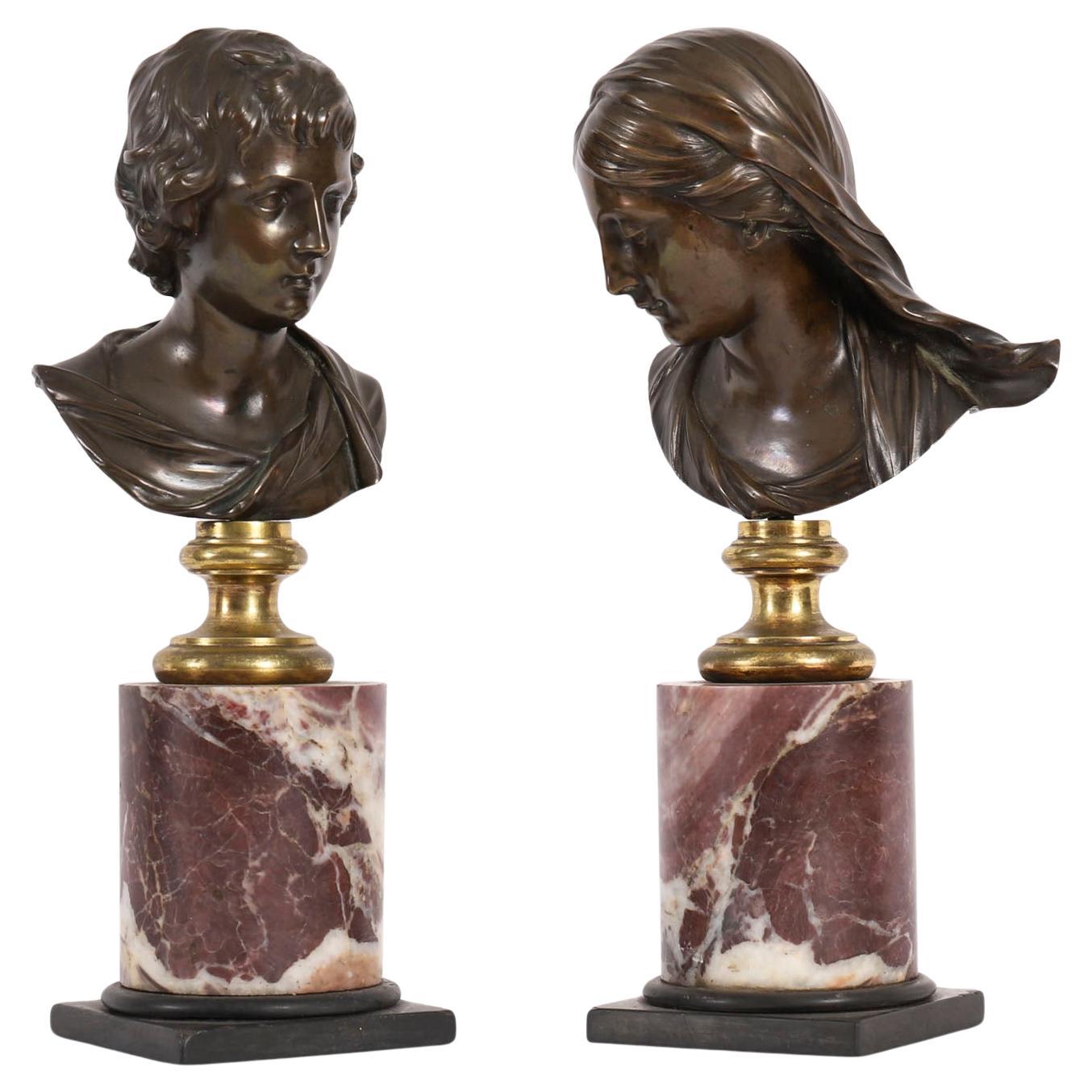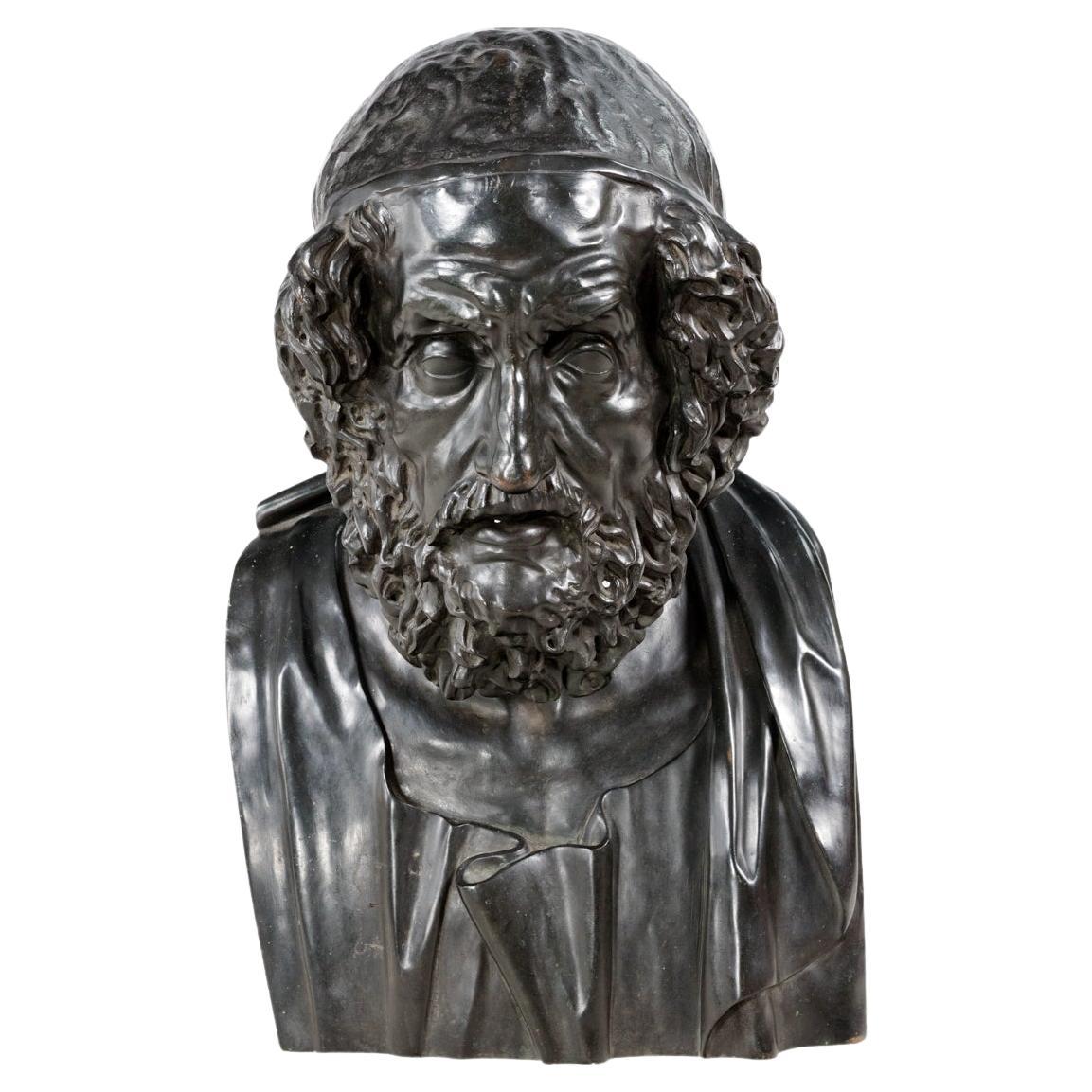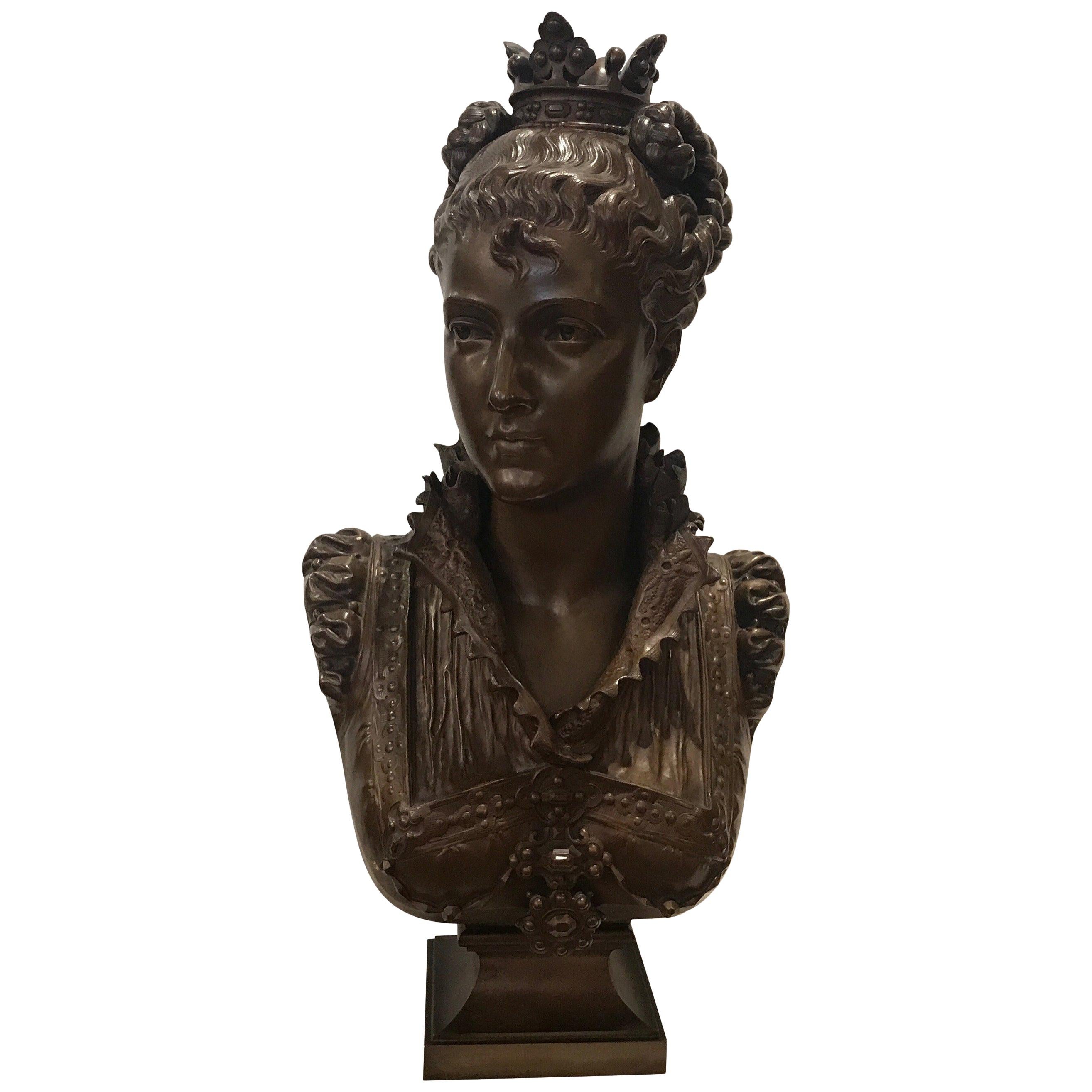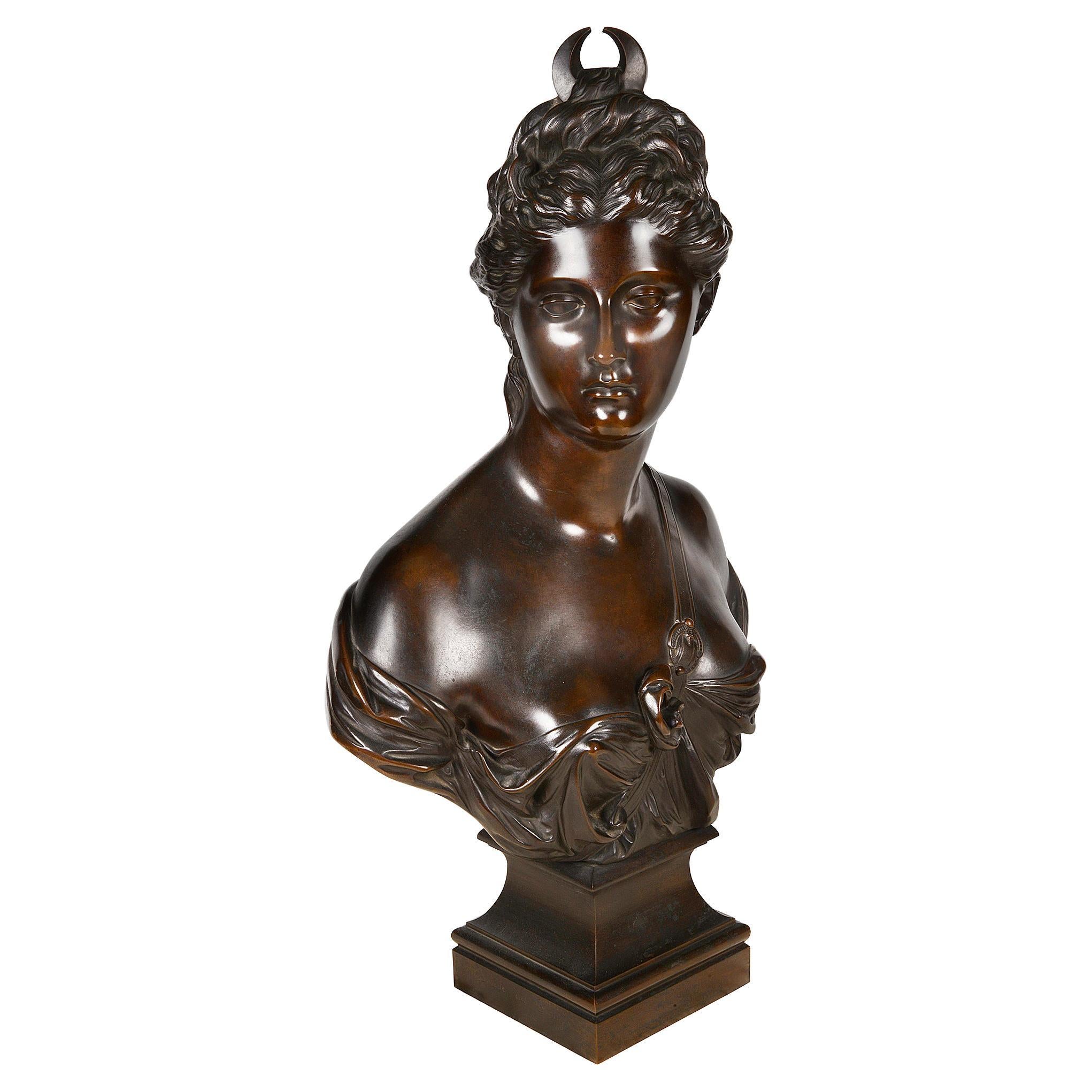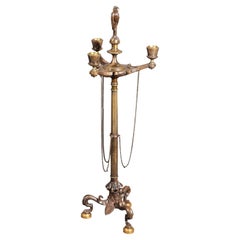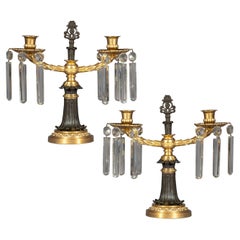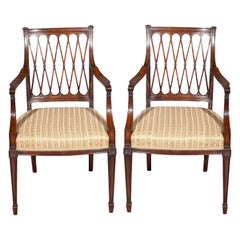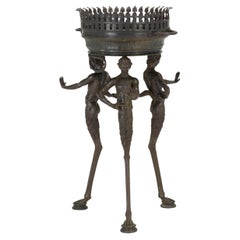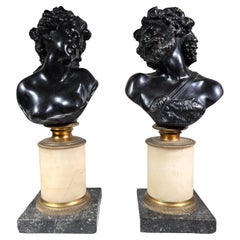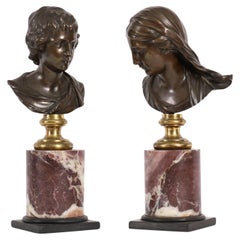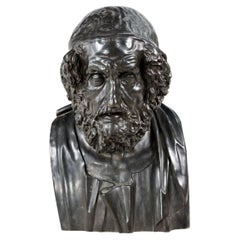Items Similar to 19th Century Bronze Bust of Dionysus by Sabatino de Angelis
Want more images or videos?
Request additional images or videos from the seller
1 of 20
19th Century Bronze Bust of Dionysus by Sabatino de Angelis
About the Item
A superb 'Grand Tour' bronze bust, traditionally described as Dionysus (Dionysos), after the original excavated at the Villa of the Papyri in 1754, by the Sabatino and Sons foundry, Naples.
Mounted on a marble socle base. Italy, 1890–1900.
Superb quality, original patination. A similar bust, though of a later date and inferior quality, was sold at Christie's London, 19 July 2022, lot 73 (£15,120).
Why we like it
Exquisitely sculpted, with beautiful patination, this handsome head has most attractive features and reflects the Ancient Greek ideal of beauty. We were captivated by its timeless beauty while on a trip to the National Archaeological Museum in Naples (last image) and later, on the island of Capri in 2020, where an identical bust could be seen at the whimsical Villa San Michele, the life’s work of the Swedish royal physician, author, and collector Axel Munthe (1857–1949). Coveted by 19th-century intellectuals and aesthetes, such exquisite objects were not mere decorations, but symbols of their owner's classical values and refined taste. Further examples graced the rooms of such style and fashion luminaries as Yves Saint Laurent, Pier Luigi Pizzi, and Karl Lagerfeld. Please, see the last five images in the listing.
History
The bust, dating from the mid-1st century AD and found in 1754 in the peristyle of the so-called Villa of the Papyri at Herculaneum, had long been misidentified as Plato, but was, in fact, an upper part of a herm, most likely of Dionysus, and is now preserved at the Naples Archaeological Museum.
Johann Joachim Winckelmann (1717–1768), a German art historian and one of the founders of scientific archaeology, wrote about this bust in his Critical Account of the Situation and Destruction by the First Eruptions of Mt. Vesuvius, of Herculaneum, Pompeii, and Stabia in 1762: "The buckles formed by the hair of the head, which has a long beard, are soldered only on the sides. The workmanship of this head is likewise worth our notice, as infinitely superior to that of all our modern artists. It is one of the most perfect pieces in the whole world; and I may take upon me to say that it is impossible for the art of man to produce anything, in any branch, superior to it..."
The Villa of the Papyri was an ancient Roman villa in Herculaneum, in what is now Ercolano, southern Italy. It is named after its unique library of papyri (or scrolls), discovered in 1750. The Villa was considered to be one of the most luxurious houses in all of Herculaneum and in the Roman world. Its luxury is shown by its exquisite architecture and by the very large number of outstanding works of art discovered, including frescoes, bronzes, and marble sculpture which constitute the largest collection of Greek and Roman sculptures ever discovered in a single context. It was situated on the ancient coastline below the volcano Vesuvius with nothing to obstruct the view of the sea. It was perhaps owned by Julius Caesar's father-in-law, Lucius Calpurnius Piso Caesoninus. In AD 79, the eruption of Vesuvius covered all of Herculaneum with up to 30 metres (98 ft) of volcanic material from pyroclastic flows. Herculaneum was first excavated in the years between 1750 and 1765 by Karl Weber by means of tunnels. Most of the villa is still underground, but parts have been cleared of volcanic deposits. Many of the finds are displayed in the Naples National Archaeological Museum.
The De Angelis Foundry (Naples, 1840–1915)
Chiurazzi, De Angelis, and Sommer were the main Neapolitan foundries that catered to the needs and tastes of the Grand Tourists throughout the 19th and early 20th centuries. The Fonderia De Angelis, active from 1840, was the oldest of the three and certainly the most prestigious. Edwan Robinson, the director of the Boston Museum of Fine Arts since 1902, wrote about its founder, Sabatino de Angelis (b.1838), being "by far the best of the Neapolitan copyists, his talent and feeling for his line of work being rare in any generation."
- Creator:Sabatino De Angelis (Maker)
- Dimensions:Height: 24.41 in (62 cm)Width: 17.72 in (45 cm)Depth: 13.78 in (35 cm)
- Style:Classical Roman (In the Style Of)
- Materials and Techniques:Bronze,Patinated
- Place of Origin:
- Period:
- Date of Manufacture:circa 1890
- Condition:Wear consistent with age and use. Ready for placement and immediate enjoyment. Superb original patination.
- Seller Location:Richmond, GB
- Reference Number:1stDibs: LU1781228390312
About the Seller
5.0
Platinum Seller
Premium sellers with a 4.7+ rating and 24-hour response times
Established in 2014
1stDibs seller since 2016
234 sales on 1stDibs
Typical response time: 4 hours
Associations
LAPADA - The Association of Arts & Antiques Dealers
- ShippingRetrieving quote...Shipping from: Richmond, United Kingdom
- Return Policy
Authenticity Guarantee
In the unlikely event there’s an issue with an item’s authenticity, contact us within 1 year for a full refund. DetailsMoney-Back Guarantee
If your item is not as described, is damaged in transit, or does not arrive, contact us within 7 days for a full refund. Details24-Hour Cancellation
You have a 24-hour grace period in which to reconsider your purchase, with no questions asked.Vetted Professional Sellers
Our world-class sellers must adhere to strict standards for service and quality, maintaining the integrity of our listings.Price-Match Guarantee
If you find that a seller listed the same item for a lower price elsewhere, we’ll match it.Trusted Global Delivery
Our best-in-class carrier network provides specialized shipping options worldwide, including custom delivery.More From This Seller
View AllAntique Bronze Etruscan Candelabrum 19th Century
By F. Barbedienne Foundry
Located in Richmond, London
An exquisitely cast and patinated bronze 'Etruscan' candelabrum in the Grand Tour taste.
France or Italy, mid- to late 19th century.
Why we like it
We love the finest quality of cas...
Category
Antique 19th Century French Grand Tour Candelabras
Materials
Bronze
19th Century Ormolu and Patinated Bronze Candelabra
Located in Richmond, London
A fine pair of Regency period gilded and patinated bronze candelabra or candlesticks.
English, circa 1810.
Why we like them
Exquisite, late neoclassical design; beautiful co...
Category
Antique Early 19th Century English Regency Candelabras
Materials
Ormolu
Pair of 19th Century Open Armchairs
By Gillows of Lancaster & London
Located in Richmond, London
A superb quality pair of open armchairs, after late 18th century designs by Gillows of Lancaster and London, the manufacture attributable to Gillow & Co. English, circa 1880.
Why we like them
Wonderfully elegant model, looking very delicate but in fact unusually strong – the sign of a skilled craftsman. Interestingly, chairs of this exact model can be seen in a painting by Walter Dendy Sadler (British, 1854-1923), The After Lunch Conversation, 1889, sold at Doyle, New York, 21 May 2024, lot 83.
Design
These chairs correspond to Gillows’ 'Garforth pattern' - a rare and highly desirable design - which first appeared in 1795 and was probably an adaptation of Georges Jacob's design of circa 1792 for Marie-Antoinette's dairy at Rambouillet. Gillows made the chairs not only in mahogany but also japanned, and they appear to have been particularly popular among the genteel, professional, and merchant classes in the north of England. In 1796, the Earl of Strafford purchased six white and green japanned chairs for Wentworth Woodhouse...
Category
Antique Late 19th Century European Armchairs
Materials
Upholstery
$5,494 / set
Set of Eight 19th Century Seagull Prints by John Gould
By John Gould and Henry Constantine Richter
Located in Richmond, London
A set of eight of exceptional quality 19th century hand-coloured lithographs, in beautiful early 20th century walnut frames
From John Gould (1804-1881), The Birds of Great Britain...
Category
Antique 19th Century English Victorian Prints
Materials
Paper, Walnut
19th Century Engraving Belisaire by Desnoyers, 1806
Located in Richmond, London
Early 19th century engraving, titled Bélisaire, after Baron François Pascal Simon Gérard's (1770 – 1837) painting Belisarius, 1797 [Getty Museum, object number 2005.10]. Engraved by ...
Category
Antique Early 19th Century French Prints
Materials
Paper
19th Century Tapestry Cushions
Located in Richmond, London
A pair of decorative loose cushions made of antique handwoven tapestry of floral design, with modern linen backing and tassel fringe edging.
French, late 19th – early 20th century.
...
Category
Early 20th Century French Charles X Pillows and Throws
Materials
Wool, Linen
$1,278 / set
You May Also Like
Bronze Pompeian Athénienne-Jardinière attributed to Sabatino De Angelis & Fils
By Sabatino De Angelis
Located in Montreal, QC
Bronze Pompeian Athénienne-Jardinière attributed to Sabatino De Angelis & Fils
The present work was inspired by a Pompeian brazier that was buried in 78 A.D. and excavated later. as ...
Category
Antique 1850s Italian Grand Tour Planters, Cachepots and Jardinières
Materials
Bronze
Antique Pair of Italian Bronze Busts: Dionysus and Ariadne, 19th Century
Located in Madrid, ES
This exquisite pair of antique Italian bronze busts represents the timeless allure of the Grand Tour era, featuring depictions of Dionysus and Ariadn...
Category
Antique 1880s Figurative Sculptures
Materials
Bronze
$2,195 Sale Price
20% Off
Antique Pair Italian Bronze Busts of Dionysus and Ariadne 19th Century
Located in London, GB
This is a fine antique pair of Italian Grand Tour solid bronze busts of Dionysus and Ariadne, circa 1860 in date.
The pair feature black patinated finely cast busts which are mount...
Category
Antique Mid-19th Century Italian Grand Tour Busts
Materials
Marble, Slate, Bronze
19th Century Bronze Bust of Homer
Located in Dublin 8, IE
19th Century bronze bust of Homer attributed to the Chiurazzi Foundry, Naples, Italy. Homer was author of the epic poems the Iliad and the Odyssey.
Category
Antique 19th Century European Neoclassical Busts
Materials
Bronze
Faure De Brouysse Bronze Bust, France, 19th Century
Located in Lambertville, NJ
A bronze portrait bust of a young aristocratic Parisian woman by Vincent-Desire Faure de Brousse, Titled "Raphaella", the woman is depicted in a lavish blouse with lace trim adorned with a lobed broach and jeweled crown headpiece...
Category
Antique 1870s French Figurative Sculptures
Materials
Bronze
19th Century Bronze bust of Diane de Houdon, Signed Bulio
By Jean Bulio
Located in Brighton, Sussex
A very good quality 19th century bronze patinated bronze bust of Diana, raised on a plinth base.
Diana is a goddess in Roman and Hellenistic religion, primarily considered a patroness of the countryside, hunters, crossroads, and the Moon. She is equated with the Greek goddess Artemis...
Category
Antique 19th Century French Busts
Materials
Bronze
Recently Viewed
View AllMore Ways To Browse
Large Busts
Rare Bust
Used Law Office Furniture
Ancient Scrolls
Antique Law Office Furniture
Used Office Furniture In Boston
Covet House
Roman Bronze Works Bronze
Bronze Head Greek
Roman Style Marble Sculpture
Marble Antique Roman Marble Heads
Greek Ad
Classical Bronze Grand Tour
Marble Sculptures 19 Century
19th Century Robinson
Bronze Head Sculpture On Marble Base
Swedish Bronze Sculpture
Naples Bronze
